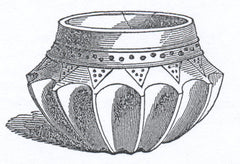Our Blog : The Origin of Christmas Gift Boxes
Hanging Gifts ON the Tree
Did you know that Christmas presents used to be hung on the tree, instead of placed under the tree? In the 1800s, Victorian ladies' magazines promoted hanging presents on a Christmas fir tree and illustrated examples of tree trimming activities such as interwoven ribbons to hold gifts like dolls, toy horses, and little wagons on the tree itself.
Some of the earliest ornaments were fruits such as apples, pears and nuts - treats to savor when the tree was taken down at the end of the Twelve Days of Christmas. As time when on, homemade sweets, such as sturdy gingerbread cookies, also awaited on the tree's branches. While these goodies could be hung on the tree's boughs by strings or cords or carefully balanced in the crook of a branch, they were more secure when tucked into a delicately woven miniature basket or folded paper cone. These presents were more of a surprise and delight when the container's contents were revealed only upon being taken off the tree. Before long, these homemade containers were used to hold small handcrafted gifts or toys for the children.
 Popular periodicals published instructions to make containers to hang on the tree, including candy boxes in various shapes and cardboard cornucopias covered in paper (see image at left). Advertisements showed fancy ready-made boxes covered with paper cutouts of Santa or angels, and embellished with velvet, feathers, or fringe. These ornate containers were both elaborate ornamentation for the tree and holders for Christmas presents like nuts, candies, small gifts and toys like marbles or jacks.
Popular periodicals published instructions to make containers to hang on the tree, including candy boxes in various shapes and cardboard cornucopias covered in paper (see image at left). Advertisements showed fancy ready-made boxes covered with paper cutouts of Santa or angels, and embellished with velvet, feathers, or fringe. These ornate containers were both elaborate ornamentation for the tree and holders for Christmas presents like nuts, candies, small gifts and toys like marbles or jacks.
Even children's periodicals featured stories of Santa himself hanging little packages and treats one by one on the family's tree, instead of inside their stockings, or under the tree.

Dresdens
Another popular way to hang presents on the tree were Dresdens - three-dimensional hollow containers made of damp cardboard sheets that were molded and embossed into all sorts of fanciful shapes, such as suns, moons, sleighs, and every animal imaginable. They were then painted and lacquered to look as if they were made of gilded metal. While they were beautiful containers in which to hang candy on the Christmas tree, they were not very durable.
Christmas Cornucopia

Dresdens

Barnum's Animal Crackers Boxes
One of the best examples of a box designed to hold treats on a Christmas tree - and still widely available today - is the Barnum's Animal Cracker's box, a favorite childhood memory for over one hundred years. In 1902, the National Biscuit Company (Nabisco) launched the circus car box as a Christmas promotion, with the string attached so that the box of Barnum's Animal Crackers could be hung directly on the Christmas tree. The string has remained a part of the package ever since then.
Bowls and Boxes of Holiday Presents
The Urn of Fate

Instead of a bowl full of jelly, how about a bowl full of presents? Ancient Romans exchanged gifts for luck in the New Year, and many Italian families still take turns drawing small gifts by chance from a large bowl called the "Urn of Fate" at their Christmas gatherings.
For more information on Italian Christmas traditions, check out this page, and this page.
Boxes of Hope and Goodwill

In the Middle Ages, earthenware boxes with a slit on top for coins became known as Christmas boxes. On the First Day of Christmas, the nobility distributed these boxes to their servants who later broke them open to receive the small sums of money inside. Other boxes were used as a Yuletide tip jar for guild tradesman (the material used for these boxes was called pygg - the predecessor of piggy banks).
During Advent, donations were collected in churches and monasteries in alms boxes also referred to as Christmas boxes. On the day after Christmas, these boxes were opened and the contents were distributed among the poor. Still other boxes were kept aboard sailing ships for donations to the priest who would offer mass - Christ-mass - prayers upon the safe return of the sailors.
Not surprisingly, the First Day of Christmas (December 26th) is still known as Boxing Day in many parts of the world that once formed the British empire.
Recent Posts
Christmas Food Traditions from Around the World
Categories
- 60 Days of Gift Ideas
- Alternative Gift Giving
- announcements
- Boxing Day
- carol
- Chipmunk Christmas
- Christmas Cake
- Christmas Carols
- Christmas Party Ideas
- Christmas Recipes
- Creatures of the Twelve Nights
- Epihpany
- Family gifts
- Fire Rituals
- food gifts
- Gift Giving Ideas
- gifts for anyone
- gifts for anyone. DIY gifts
- gifts for babies
- gifts for her
- gifts for kids
- gifts for men
- gifts for teens
- gifts for under $10
- gifts for under $20
- gifts for under $30
- gifts for women
- Hanging Gifts ON the Tree
- Hippo Christmas
- History of Christmas Carols
- Holiday Decorating Ideas
- Last Minute Gifts
- Learn More About the Twelve Days of Christmas
- muppets
- New Christmas Traditions
- outdoorsy
- shipping
- Significance of Number Twelve
- Significance of Winter Greenery
- song
- sports gifts
- Stocking Stuffers
- techie/gadget gifts
- The Origin of Christmas Gift Boxes
- Twelfth Day of Christmas
- Twelfth Night
- Twelfth Night Cake
- Twelfth Night Party
- Twelve Days gifts
- Twelve Days Recipes
- Twelve Days-Themed Gifts
- video
- Wassail
- Where to shop for Twelve Days Gifts
- wine gifts
- Winter Solstice Rituals
- Woman's Christmas